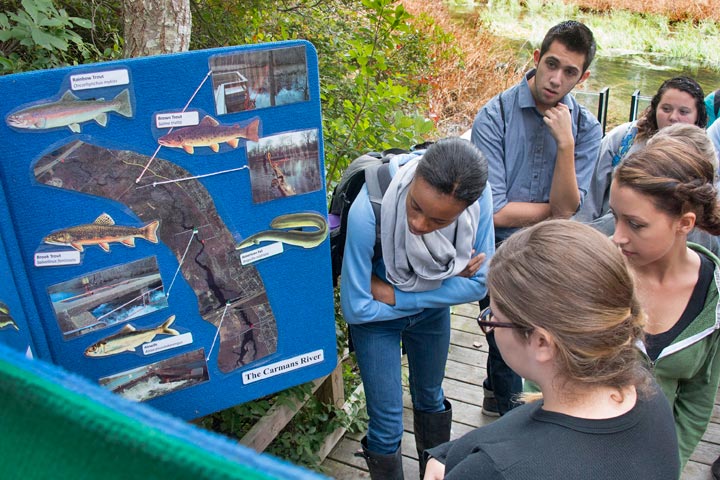'A Day in the Life of the Carmans River'
October 30, 2013
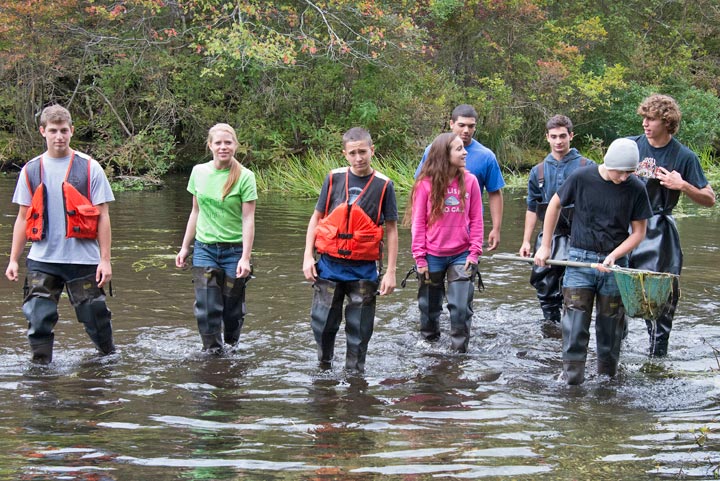 enlarge
enlarge
Students from Patchogue-Medford High School, one of six schools that participated in the second annual "Day in the Life of the Carmans River" workshop on Sept. 27
Fish using EZ-Pass? Suiting up in boots and waders? Those don’t sound like part of a normal school day, but Sept. 27 wasn’t a normal school day for 380 students from six schools near Brookhaven Lab. It was the second annual “Day in the Life of the Carmans River” workshop.
“This helps make a real world connection to understand the subject. What better way to experience environmental sciences?”
— Maiquela Richards, Patchogue-Medford High School
During this daylong event, some students and teachers—from Bellport, Longwood, Patchogue-Medford, Rocky Point, and William Floyd High Schools, and Nathaniel Woodhull Elementary School—caught and counted fish while others collected and analyzed water samples or identified invasive plant species. Using the measurements they collected, such as the river’s salt content and clarity as well as erosion and breeding patterns for fish, the students will investigate a number of effects to develop a complex snapshot of the Carmans River’s ecosystem, which starts from groundwater sources in Middle Island and flows 10 miles south to the Great South Bay. They will also compare their data with last year’s to determine how Superstorm Sandy and a resulting new inlet on Fire Island may have affected the river.
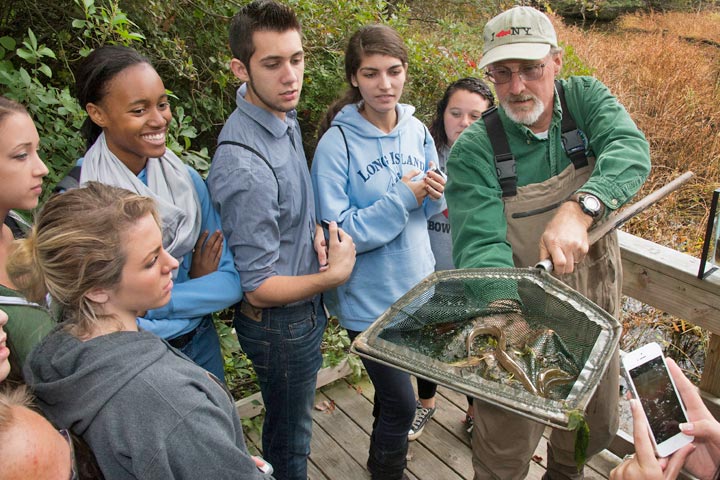 enlarge
enlarge
Charles Guthrie of the New York State Department of Environmental Conservation shows students the contents of his catch, which included an eel.
“Bringing young people out to breath the fresh air, see the wildlife, and determine how this ecosystem changes is one of the best ways to help develop future scientists and informed, responsible citizens who care for the environment,” said Mel Morris of Brookhaven Lab’s Office of Educational Programs. He helped organize the event that that was based on a similar program for the Hudson River region upstate. Morris also founded and oversees the Lab’s Open Space Stewardship Program, which was designed to help local land stewards manage their properties with students who, as “citizen scientists,” learn about the scientific process while going out to the field to collect useful data.
Exploring With Local Experts
The 2013 “Day in the Life of the Carmans River” program was sponsored by Brookhaven Lab, the Central Pine Barrens Joint Planning and Policy Commission, and the New York State Department of Environmental Conservation. At different stations along the river, the students met experts from those institutions, including the Lab’s Office of Educational Programs and Environmental Protection Division, as well as the Art Flick chapter of Trout Unlimited, the Brook Trout Coalition, Cornell Cooperative Extension of Suffolk County, Ducks Unlimited, Eastern Suffolk BOCES, Foundation for Ecological Research in the Northeast (FERN), Post Morrow Foundation, Suffolk County Parks Department, Town of Brookhaven, Wertheim National Wildlife Refuge, and U.S. Geological Survey.
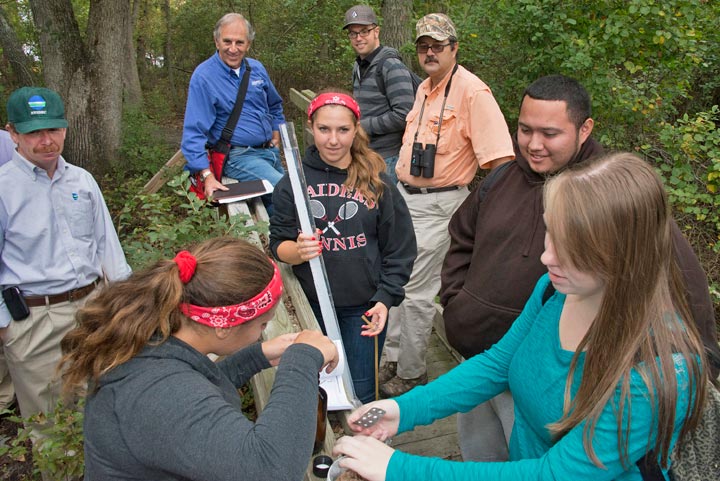 enlarge
enlarge
Students check water samples from the river with Peter Scully of the Central Pine Barrens Joint Planning and Policy Commission (back, left), Mel Morris of Brookhaven Lab's Office of Educational Program (back, second from left), and Tim Green of the Lab's Environmental Protection Division (back, fourth from left.)
These local experts coached the students and showed them different ways they study the river to protect it while determining how its ecosystem changes. One interesting method the researchers use involves implanting small EZ-Pass-type sensors in some fish. These sensors are detected and counted as the fish swim to different parts of the river, and researchers compile this data to understand more about where the fish feed and breed.
‘What Better Way to Experience Environmental Sciences?’
Brookhaven Town Supervisor Ed Romaine stopped by in the morning to meet the students along the river. “It’s only by gathering data that we can monitor the health of the river,” he said. “You’re taking the river’s blood pressure right now. Thank you.”
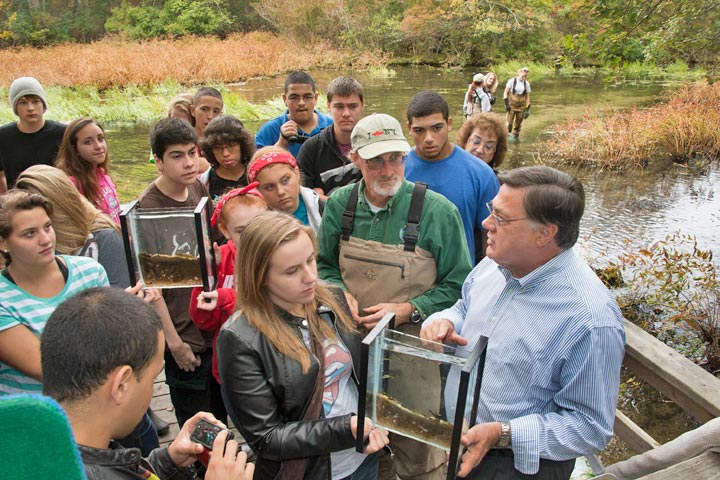 enlarge
enlarge
Brookhaven Town Supervisor Ed Romaine thanked the students for "checking the river's blood pressure."
Bob Borowski teaches an advanced placement, environmental science class at Patchogue-Medford High School and has now brought students to participate in the program two years in a row. “I’m a big supporter of learning from experience and today the kids are outside, they’re taking measurements—they’re learning science,” he said.
“It’s one thing to read something in a textbook, but today we’re experiencing what we talked about in class,” explained Maiquela Richards, a senior in Borowski’s class. “This helps make a real world connection to understand the subject. What better way to experience environmental sciences?”
Students in science classes weren’t the only ones to join in the day’s events. Helping connect science with other important disciplines, Borowski also enrolled members of the school’s photography club, who documented their classmates’ findings and adventures in the river.
Students who participated presented some of their results at the eighteenth annual Pine Barrens Research Forum held at Brookhaven Lab on Oct. 3 and 4. Not only did students present their findings to forum attendees—they also got to share their results, via web conferencing, with students across the big pond who participated in a similar event along Italy’s Arno River.
2013-4371 | INT/EXT | Newsroom




